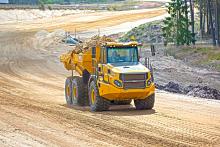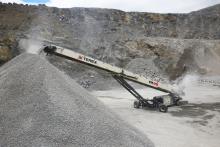
Peter-Valentin Sauter, a
Good quarry haul road design equals safer trucks travelling within their target payload in safe conditions at the rated speed in all day and night weather
Crowned straight sections, super-elevated curves, and safety berms with drainage ditches on both sides, constructed with well graded sub-base material are the hallmarks of a quality quarry haul road. Proper lighting in the load and dump areas is also key for night working.
Two-way traffic must be accommodated on the haul roads of the bulk of European quarries. Three truck widths is preferred for straight haul road section travel at day or night. However, this rises to at least four truck widths when applied to corners and curves. Such distance allows safe and constant speed passing of loaded and unloaded trucks. For optimum operator visibility, including the avoidance of blind spots in curves and at the top of the grade, correct haul road width is vital.
In reality, there will be areas where the ideal truck widths are unachievable. In these instances, truck speed needs to be cut and speed limit signs introduced and thoroughly policed.
Safety berms measuring at least one-half of the wheel height of a fleet’s largest truck are usually a must for guarding haul roads.
To facilitate water drainage, well designed haul roads are crowned in their straight sections. Around 2% is sufficient for most regions, although 3% may be required in higher rainfall areas.
Day and night shift extraction and hauling is the norm in a large number of quarries. This makes it essential for quality lighting equipment to be sited at crucial areas of the haul road and the load and dump points to improve visibility, thus enhancing safety.
Unwelcome and potentially costly extreme tyre wear and tread separation can be generated by the high lateral tyre forces trucks generate negotiating haul road curves. This can be partly countered by super-elevation: the difference in height between the inside and outside edges of a banked road’s bed.
Well-designed super-elevated curves ensure the load is correctly positioned over the tyres and truck chassis, lowering side forces on the tyre casing, leading to less scuffing and wear. Furthermore, super-elevation leads to more consistent and safer truck speeds. Consistent truck speed maintenance allows for optimum fuel efficiency. Super-elevation levels are based on the curve’s radius and the speed at which it is negotiated.
It’s key to achieve the right grade for each haul road grade, as it impacts on where the load rests on the tyres and reduces rock spillage on the haul road. The ideal ratio is 33% of the load to be in the front of the truck and 66% to be in the rear, and the perfect grade is 8-10%.
Constant grades also cut transmission up/down shifting, lowering fuel consumption and raising drivetrain component life.
Due to it starting at the loading face and ending at the dump point, the haul road’s load and dump sites should be smooth and without rocks and potholes. Appropriate design of the bench and dump sites can prevent spillages and wear and tear on the tyres whilst, concurrently, cutting the risk of accidents.
The greatest risk of cut and damaged tyres is caused by rocks, debris and potholes on the haul road. When in contact with a rock, a tyre’s tread can be cut or its belting separate, sapping the tyre’s strength. Ensuring haul roads are rock- and other debris-free should be a priority on all quarry sites keen to optimise tyre life and safety.
Meanwhile, airborne dust and debris can harm operator visibility and therefore site safety, so effective dust control is crucial. Excellent haul road maintenance can be achieved with appropriate equipment and well trained personnel. A motor grader driven by a trained operator is crucial for cleaning and grading haul roads. And deploying a water truck with a trained operator is key to dust control. Long-term proper grades, rolling resistance and dust control are critical elements of a successful and safe quarry business.
Any employee working in the quarry and aggregates sector needs to be familiar with quarry highwall safety. Hazard recognition highwall safety training is encouraged, in which employees are asked to identify many elements during an exam such as cracking, rutting, loose ground, sloughage and large rocks causing obstacles. On occasions when material requires dumping over a berm, this should be done while keeping to safety height guidelines. Safety berm heights are recommended to be at least half the wheel height of the largest piece of on-site equipment. Any changes on the highwall during one shift should be communicated to the next shift personnel. Loose material needs to be scaled before performing work. It’s important to remember to position shovels and trucks so that cabs swing away from the highwall during loading.
Operator training is vital for safety and important in all other elements of quarry operations. Motor grader operators should be well versed in how to thoroughly maintain haul roads, thus ensuring ideal and safe hauling conditions.
Truck operators need to appreciate how their driving technique has an impact on safety, tyre life and fuel consumption.
Daily safety and inspection walk-arounds of the truck should be carried out by the operator to potentially flag up safety issues. Safety checks should include a tyre pressure check and visible tyre cuts.
A potential danger for daily machine operators and work site visitors can be found in site traffic flow. Each traffic and directional sign must be in decent working condition. All employees and site visitors must be trained on safety and correct traffic flow and are able to abide by site rules. Some jobsites, for example, have a left-hand traffic pattern which allows enhanced visibility of the ditch line and is safer in wet conditions. Right of way determines which vehicle moves first when at least two pieces of equipment are in the same area at the same time. Right of way should be predetermined by the site management and conveyed to all individuals using the haul roads. In quarries, heavy equipment usually has the right of way.
Quarry class off-highway trucks boast the same engineering design and upgraded features found on bigger mining class trucks. One example is the Cat Road Analysis Control (RAC) system available for many years in Cat mining trucks now being available at the larger end of the quarry class trucks, such as the Caterpillar 777G.
Quarry trucks aid quarry managers in their management of haul roads and in increasing truck life. With cutting-edge advancements in design and manufacture, the comfort now offered on board an off-highway truck means its operator may not gain sufficient road-feel to detect damaged road conditions that can impact cost and productivity, and reduce truck life as a result of damage to frames, tyres, rims, and power train components.
However, Road Analysis Control (RAC), a haul road management tool, gives operators feedback on road conditions, quantifies the severity of the condition, and allows quarry bosses to make more informed haul road maintenance decisions aimed at cutting overall costs.
An onboard information technology tool designed to measure and benchmark haul road quality, RAC is integrated with the Vital Information Management System of the machine, measuring component loading and impact shock and sending that data to the operator and quarry office in real time. GPS equipped trucks can identify coordinates and broadcast them to other trucks, support equipment, and maintenance vehicles. RAC’s data and reports allow quarry managers to quantify, monitor and manage haul road deterioration to enhance truck longevity and, crucially, reduce cost per tonne of moved material.
Summing up, a badly maintained, bump and pot hole heavy haul road can dramatically reduce component life and, as thus, escalate repair bills. A considerately designed and maintained haul road prevents accidents, lowers fuel consumption, increases tyre life and allows higher production speed and therefore shorter cycle times.








